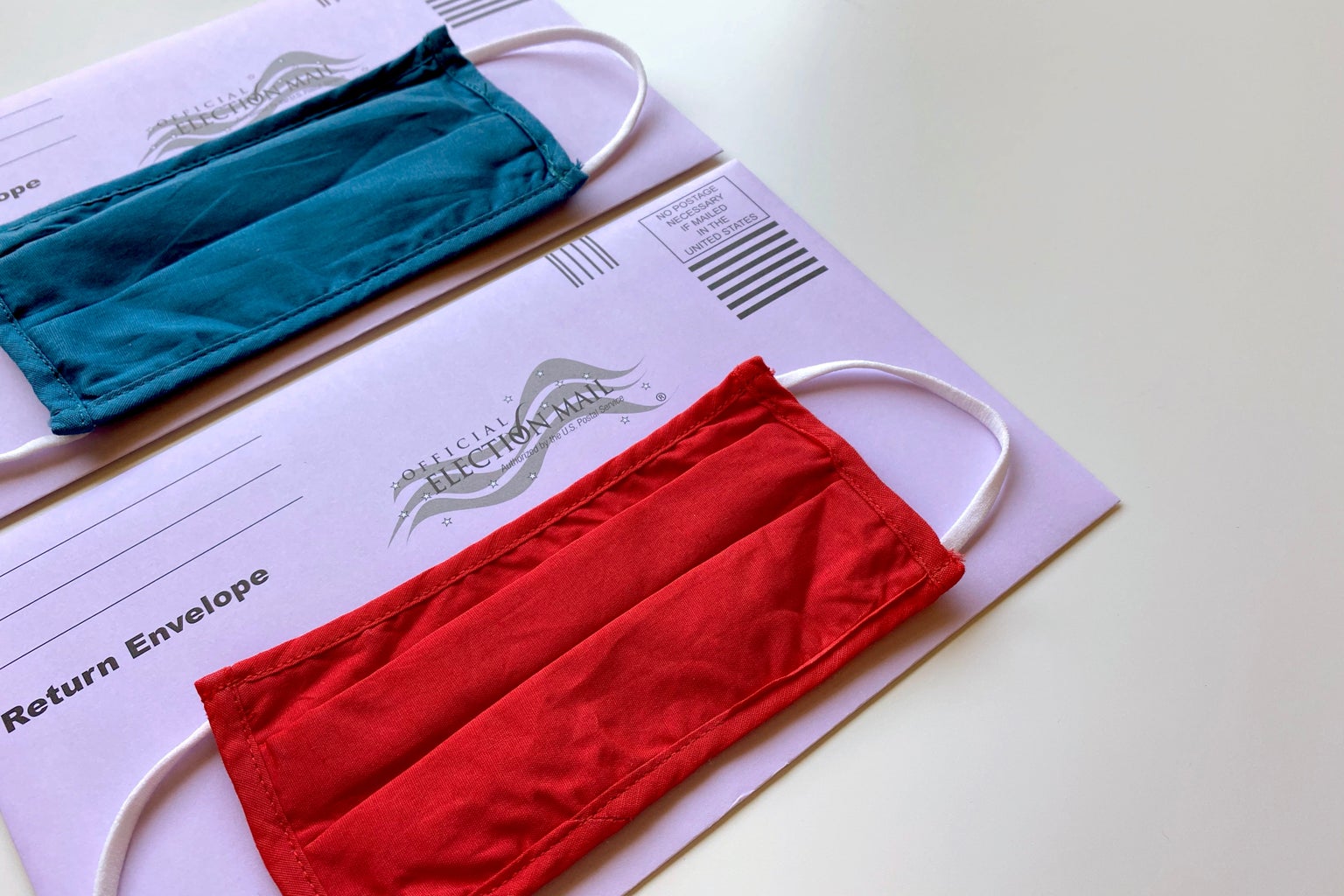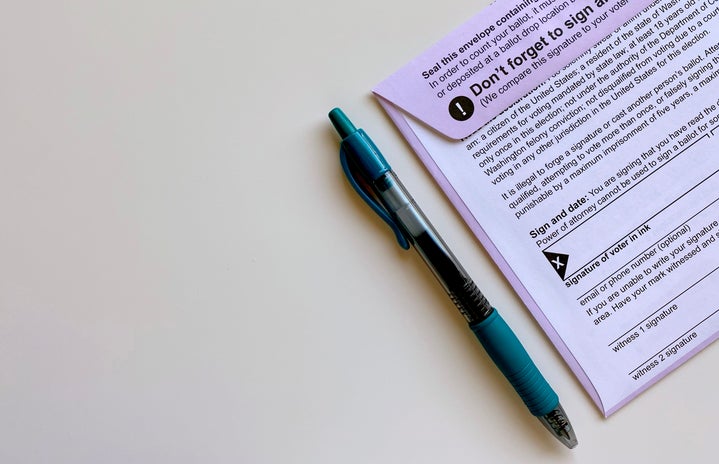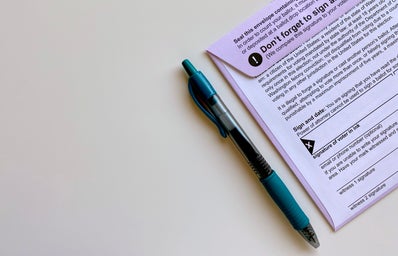By Ellie Sullum, Campus Election Engagement Project
Did you ever see yourself rolling up to a protest with #SaveUSPS painted on cardboard? I didn’t. Yet, here we are. As summer fades, the smallest realm of joyful haze and relaxation we were afforded amongst global chaos is being ripped off like a bandage. What’s left is a monumental, very uncertain election. This election heavily relies on a system of voting — voting by mail — which is unfamiliar to many members of the electorate. Luckily, organizations like Campus Election Engagement Project (CEEP) are easing some of this uncertainty.
So, what exactly is voting by mail?
Voting by mail or dropbox (receiving your ballot in the mail and then dropping it off at a secure designated location) is a relatively new alternative to voting in-person on Election Day for many states. Instead of casting your ballot at the polls, voting by mail gives you the option to receive your ballot in the mail and return it to the United States Postal Service (USPS). However, for young voters like you and me, the process of voting itself can often already feel tricky to navigate during a normal election. In the midst of a pandemic, this year’s rapid overhaul from in-person voting to voting by mail can amplify this stress.
To add to the mess, voters are experiencing tons of frustration and misinformation surrounding the process. All summer, online media was saturated with resistance toward vote by mail.
A lot of voters, including young voters, don’t trust it. Mistrust in vote by mail comes from a historical pattern of loyalty to in-person voting, uncertainty about the process, and political leaders who take advantage of people’s uncertainty about it to spread misinformation.
I grew up in Pennsylvania, a state that until last years’ legislative session only allowed excused absentee voting (a form of voting by mail) as an alternative to in-person voting. Excused absentee voting is when voters must meet specific, narrow requirements to send in an absentee ballot.
Because of COVID-19 concerns however, the Pennsylvania Department of State has completely transformed their voting system. They are now allowing every person to vote by mail without an excuse. To encourage more people to vote by mail instead of showing up in-person on Election Day, they’ve even pledged to cover the cost of mail in ballot postage. They are hoping this pledge will serve as enough motivation for millions of Pennsylvania voters to vote by mail.
While Pennsylvania recently adopted voting by mail for all voters, some states adopted it awhile ago. I now live in Colorado, which runs the most robust and advanced vote by mail system in the country. In June, their Statewide Primary Election resulted in a 1.4 million voter turnout, with 99.3% of voters mailing in or dropping off ballots.
Unfortunately, Colorado remains the exception this election cycle. Many more states are closer to Pennnsylvania than Colorado. As a result, voters everywhere are hesitant to trust the USPS with their ballot. While many state and national leaders are working to familiarize voters with the process through education and words of encouragement, others are working to spread fear and mistrust of the system.
Before I go on, I want to be clear: voting is a constitutional right and a civic duty. Voting is not a partisan activity. The voting method you choose is not a partisan choice. Providing more opportunities for people to vote in light of a pandemic should not be partisan.
Unfortunately, that’s not how everyone perceives it. Today’s political rhetoric about voting by mail has historical ties. Increasing opportunities for voters to cast their ballots has turnout implications for both major political parties. Some communities are disproportionately affected by increasing or decreasing voting accessibility, while others are not.

Students voters are among many rising voting blocs who historically experience barriers to voting.
The most common barriers for students are lack of voter education and limited access to the polls. After over four years in college spent empowering students to become voters, I often hear students say they feel like voting is another test they don’t know enough about or feel their vote doesn’t matter. Many more try to exercise their right to vote, only to experience targeted voter suppression. Student voters often lack the resources and encouragement to vote with confidence.
In 2018, we were so hopeful. During the 2018 midterms, over 7.5 million college students voted. More people under the age of 40 voted than people over the age of 60. However, such progress remains in jeopardy this year. Rather than maintain ballot access on principle, many of our nation’s leaders remain more interested in securing results. Thus, misinformation about vote by mail is spread, and threats to the USPS are made. Combined with a lack of vote by mail experience, young voters like you and me are frazzled, trying to sort fact from fiction, wondering if voting is worth the attempt.
By virtue of human nature, people are more motivated to engage in activities that feel familiar and safe. Vote by mail is a relatively new process for tens of millions of voters.
From a branding standpoint, Vote By Mail and the USPS are facing serious backlash. Misinformation about vote by mail, or gossip — as I often think of it, takes the form of delegitimizing the integrity of voting by mail as a failure on the part of the USPS. The gossip starts at the top, and quickly flows down to ordinary, concerned voters. As a result, voters across the country are hesitant to vote by mail based on a foundation of mistruths. I can’t sit here and blame young voters for mistrusting voting by mail in good conscience. Instead, it’s my mission to flip the narrative, separate the facts, and continue to make student voters feel educated and confident. I belong to a nonpartisan line of work, and I believe in voting for the sake of engaging in democracy.
If you’re reading, your vote matters. All votes matter. Democracy only functions when a diverse electorate participates. Vote by mail is a highly legitimate and secure process. All voters deserve to access it this election, regardless of who they vote for.
The first step to combat the stress and anxiety surrounding voting by mail is education.
Campus Election Engagement Project (CEEP), a national nonpartisan organization whose mission is to empower the next generation of student voters, sought to debunk misinformation about the process and encourage people to use it. Your Vote Matters: Vote By Mail is a short video series jam packed with exactly what you need to know to vote safe, secure, and with confidence.
Vote By Mail: Myths vs. Facts sets the record straight about vote by mail. The one minute video combats common misinformation and affirms the secure nature of the process. By knowing the facts, people can trust in the USPS — the same system that mails us our prescriptions, passports, renewed licenses, and keeps our mail private.
As young voters, we should take this knowledge and amplify it the best we know how: sharing with our friends and family. Know someone who doesn’t feel comfortable with voting by mail? Share these videos with them! It’s literally the length of a Tik Tok, so they have time for it, I promise.
Also the length of a Tik Tok is COVID No: Voting Yes! If you’re wondering if you should vote by mail, this one’s for you. It dives into the impact of COVID-19 on the 2020 election, and why voting by mail or dropbox is a safe and secure choice during such uncertain times.
And of course, if you and your friends are convinced that voting by mail is the right choice for you, but aren’t sure how — we’ve got you covered. How Do I Vote By Mail walks you straight through the process using the Four R’s: Register, Request, Read, Return.
I want all student voters to participate in such a monumental election. I want all students to be voters and to choose to engage in the political process year round. Voters need confidence to navigate the process. For millions of Gen Z women, it starts here.


